lock CHEVROLET EXPRESS 2010 Owner's Guide
[x] Cancel search | Manufacturer: CHEVROLET, Model Year: 2010, Model line: EXPRESS, Model: CHEVROLET EXPRESS 2010Pages: 440, PDF Size: 2.42 MB
Page 70 of 440
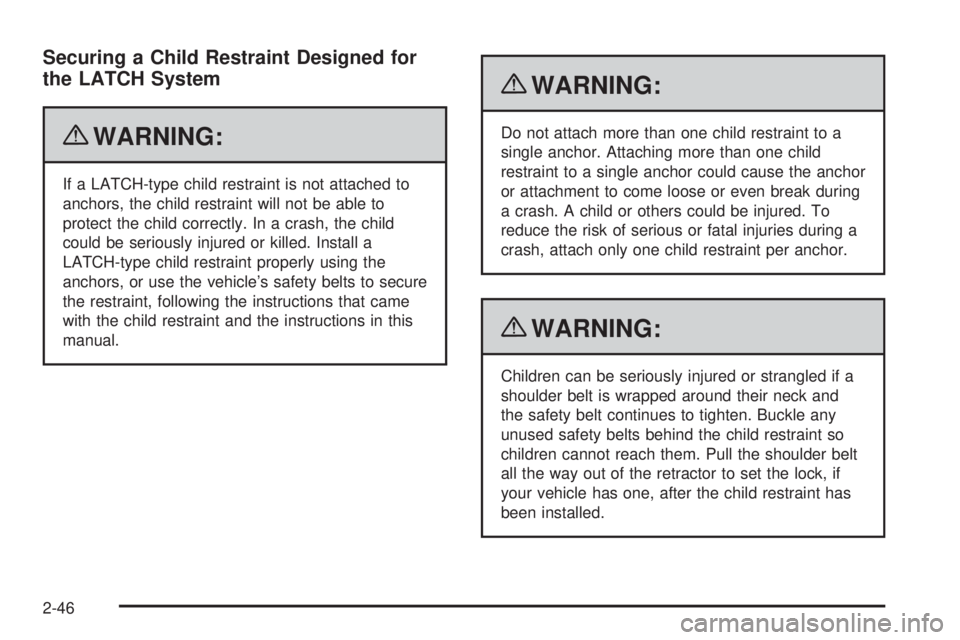
Securing a Child Restraint Designed for
the LATCH System
{WARNING:
If a LATCH-type child restraint is not attached to
anchors, the child restraint will not be able to
protect the child correctly. In a crash, the child
could be seriously injured or killed. Install a
LATCH-type child restraint properly using the
anchors, or use the vehicle’s safety belts to secure
the restraint, following the instructions that came
with the child restraint and the instructions in this
manual.
{WARNING:
Do not attach more than one child restraint to a
single anchor. Attaching more than one child
restraint to a single anchor could cause the anchor
or attachment to come loose or even break during
a crash. A child or others could be injured. To
reduce the risk of serious or fatal injuries during a
crash, attach only one child restraint per anchor.
{WARNING:
Children can be seriously injured or strangled if a
shoulder belt is wrapped around their neck and
the safety belt continues to tighten. Buckle any
unused safety belts behind the child restraint so
children cannot reach them. Pull the shoulder belt
all the way out of the retractor to set the lock, if
your vehicle has one, after the child restraint has
been installed.
2-46
Page 74 of 440
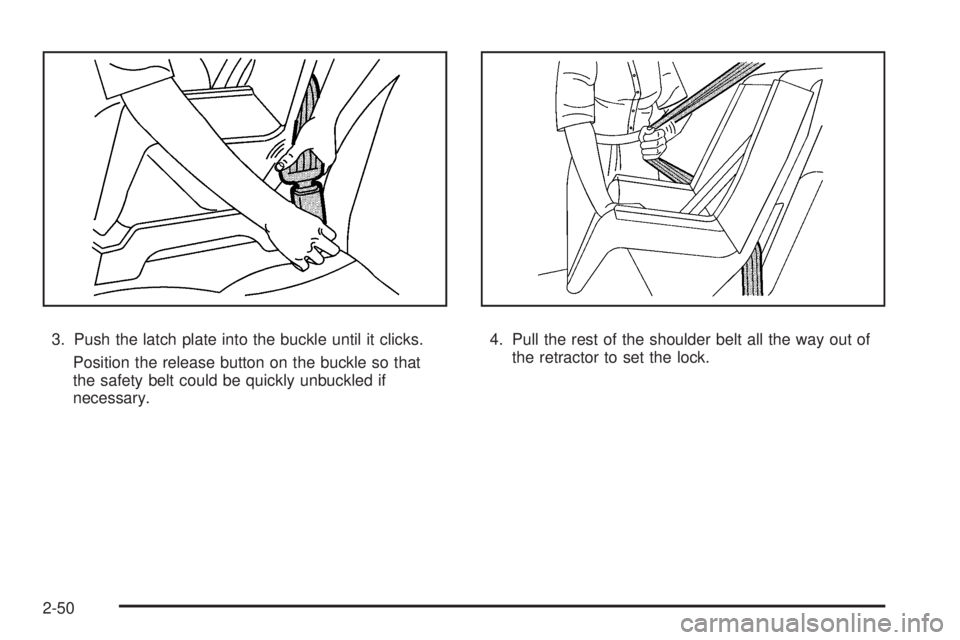
3. Push the latch plate into the buckle until it clicks.
Position the release button on the buckle so that
the safety belt could be quickly unbuckled if
necessary.4. Pull the rest of the shoulder belt all the way out of
the retractor to set the lock.
2-50
Page 78 of 440
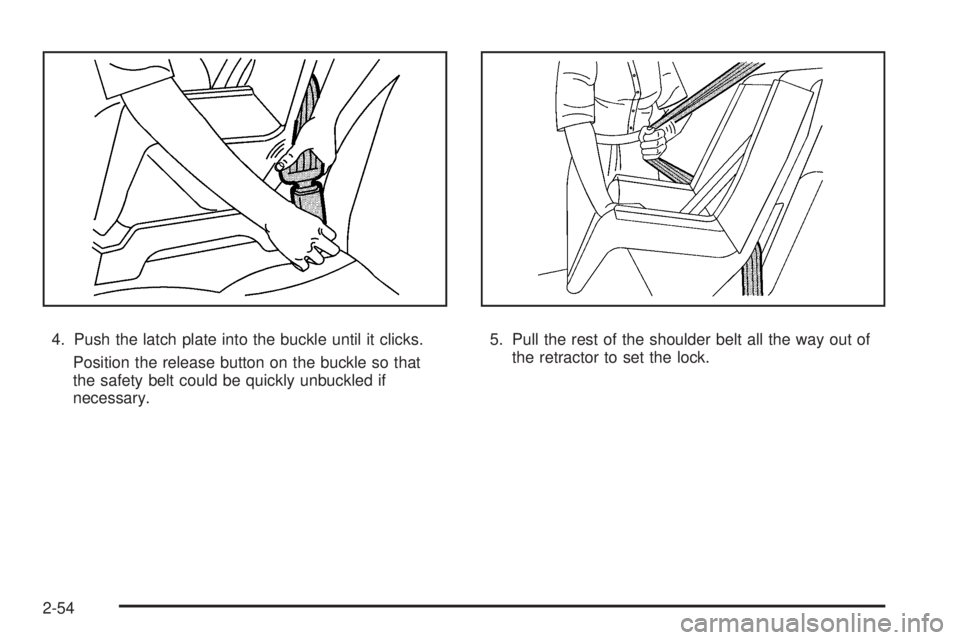
4. Push the latch plate into the buckle until it clicks.
Position the release button on the buckle so that
the safety belt could be quickly unbuckled if
necessary.5. Pull the rest of the shoulder belt all the way out of
the retractor to set the lock.
2-54
Page 82 of 440
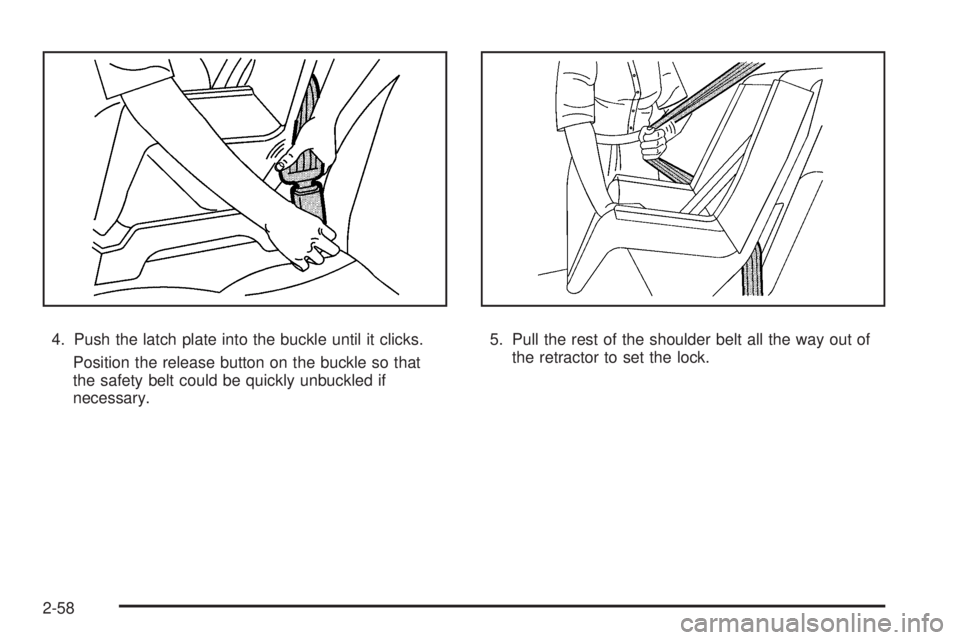
4. Push the latch plate into the buckle until it clicks.
Position the release button on the buckle so that
the safety belt could be quickly unbuckled if
necessary.5. Pull the rest of the shoulder belt all the way out of
the retractor to set the lock.
2-58
Page 89 of 440
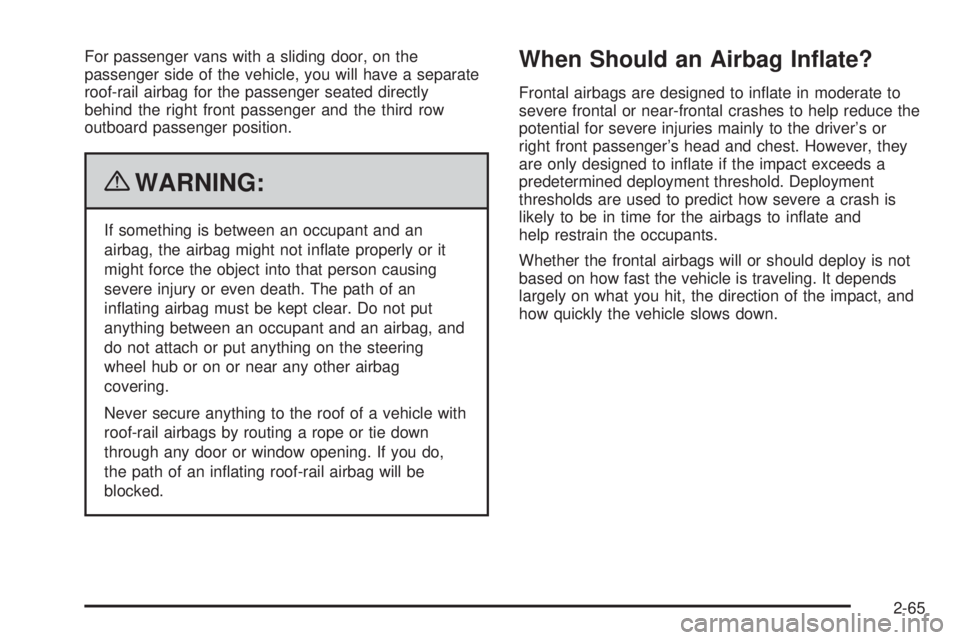
For passenger vans with a sliding door, on the
passenger side of the vehicle, you will have a separate
roof-rail airbag for the passenger seated directly
behind the right front passenger and the third row
outboard passenger position.
{WARNING:
If something is between an occupant and an
airbag, the airbag might not inflate properly or it
might force the object into that person causing
severe injury or even death. The path of an
inflating airbag must be kept clear. Do not put
anything between an occupant and an airbag, and
do not attach or put anything on the steering
wheel hub or on or near any other airbag
covering.
Never secure anything to the roof of a vehicle with
roof-rail airbags by routing a rope or tie down
through any door or window opening. If you do,
the path of an inflating roof-rail airbag will be
blocked.
When Should an Airbag In�ate?
Frontal airbags are designed to inflate in moderate to
severe frontal or near-frontal crashes to help reduce the
potential for severe injuries mainly to the driver’s or
right front passenger’s head and chest. However, they
are only designed to inflate if the impact exceeds a
predetermined deployment threshold. Deployment
thresholds are used to predict how severe a crash is
likely to be in time for the airbags to inflate and
help restrain the occupants.
Whether the frontal airbags will or should deploy is not
based on how fast the vehicle is traveling. It depends
largely on what you hit, the direction of the impact, and
how quickly the vehicle slows down.
2-65
Page 92 of 440
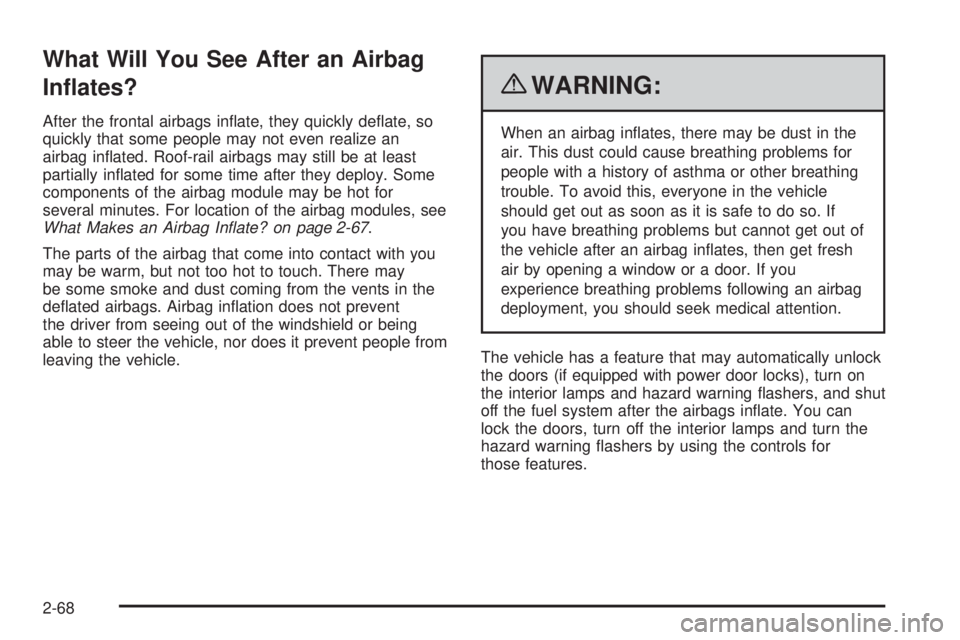
What Will You See After an Airbag
In�ates?
After the frontal airbags inflate, they quickly deflate, so
quickly that some people may not even realize an
airbag inflated. Roof-rail airbags may still be at least
partially inflated for some time after they deploy. Some
components of the airbag module may be hot for
several minutes. For location of the airbag modules, see
What Makes an Airbag In�ate? on page 2-67.
The parts of the airbag that come into contact with you
may be warm, but not too hot to touch. There may
be some smoke and dust coming from the vents in the
deflated airbags. Airbag inflation does not prevent
the driver from seeing out of the windshield or being
able to steer the vehicle, nor does it prevent people from
leaving the vehicle.
{WARNING:
When an airbag inflates, there may be dust in the
air. This dust could cause breathing problems for
people with a history of asthma or other breathing
trouble. To avoid this, everyone in the vehicle
should get out as soon as it is safe to do so. If
you have breathing problems but cannot get out of
the vehicle after an airbag inflates, then get fresh
air by opening a window or a door. If you
experience breathing problems following an airbag
deployment, you should seek medical attention.
The vehicle has a feature that may automatically unlock
the doors (if equipped with power door locks), turn on
the interior lamps and hazard warning flashers, and shut
off the fuel system after the airbags inflate. You can
lock the doors, turn off the interior lamps and turn the
hazard warning flashers by using the controls for
those features.
2-68
Page 107 of 440
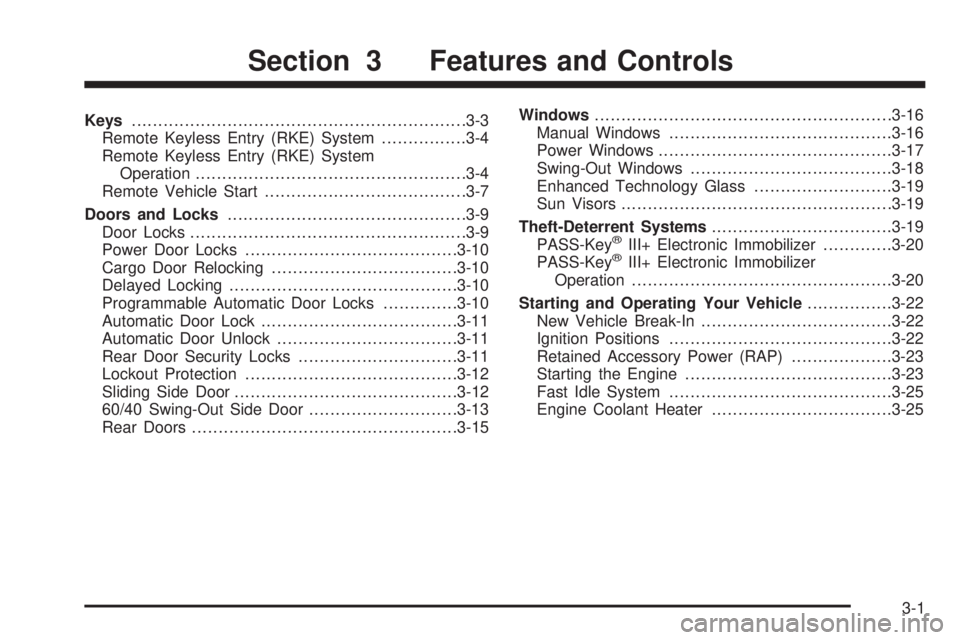
Keys...............................................................3-3
Remote Keyless Entry (RKE) System................3-4
Remote Keyless Entry (RKE) System
Operation...................................................3-4
Remote Vehicle Start......................................3-7
Doors and Locks.............................................3-9
Door Locks....................................................3-9
Power Door Locks........................................3-10
Cargo Door Relocking...................................3-10
Delayed Locking...........................................3-10
Programmable Automatic Door Locks..............3-10
Automatic Door Lock.....................................3-11
Automatic Door Unlock..................................3-11
Rear Door Security Locks..............................3-11
Lockout Protection........................................3-12
Sliding Side Door..........................................3-12
60/40 Swing-Out Side Door............................3-13
Rear Doors..................................................3-15Windows........................................................3-16
Manual Windows..........................................3-16
Power Windows............................................3-17
Swing-Out Windows......................................3-18
Enhanced Technology Glass..........................3-19
Sun Visors...................................................3-19
Theft-Deterrent Systems..................................3-19
PASS-Key
®III+ Electronic Immobilizer.............3-20
PASS-Key®III+ Electronic Immobilizer
Operation.................................................3-20
Starting and Operating Your Vehicle................3-22
New Vehicle Break-In....................................3-22
Ignition Positions..........................................3-22
Retained Accessory Power (RAP)...................3-23
Starting the Engine.......................................3-23
Fast Idle System..........................................3-25
Engine Coolant Heater..................................3-25
Section 3 Features and Controls
3-1
Page 109 of 440
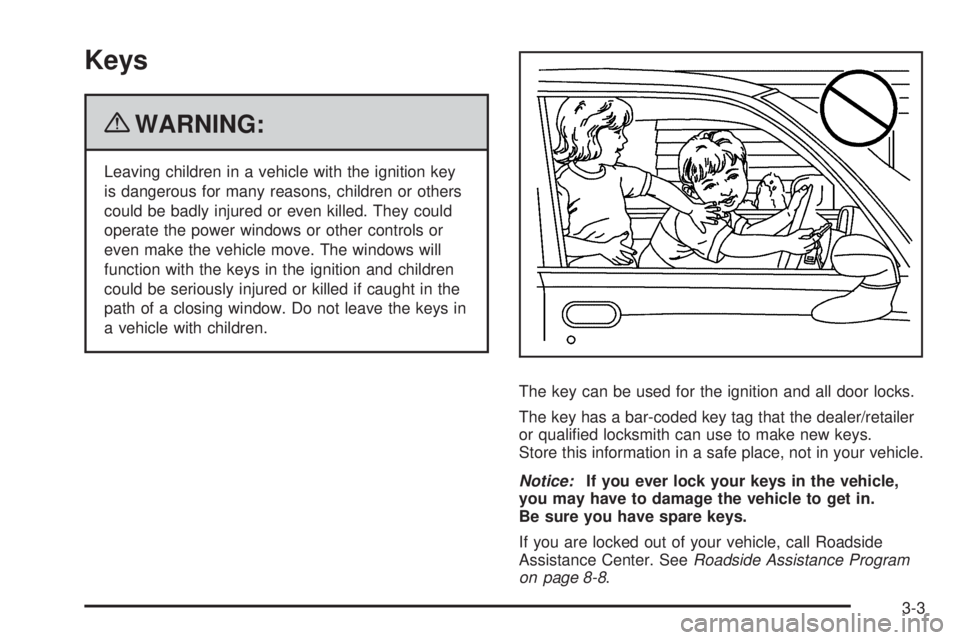
Keys
{WARNING:
Leaving children in a vehicle with the ignition key
is dangerous for many reasons, children or others
could be badly injured or even killed. They could
operate the power windows or other controls or
even make the vehicle move. The windows will
function with the keys in the ignition and children
could be seriously injured or killed if caught in the
path of a closing window. Do not leave the keys in
a vehicle with children.
The key can be used for the ignition and all door locks.
The key has a bar-coded key tag that the dealer/retailer
or qualified locksmith can use to make new keys.
Store this information in a safe place, not in your vehicle.
Notice:If you ever lock your keys in the vehicle,
you may have to damage the vehicle to get in.
Be sure you have spare keys.
If you are locked out of your vehicle, call Roadside
Assistance Center. SeeRoadside Assistance Program
on page 8-8.
3-3
Page 110 of 440

Remote Keyless Entry (RKE)
System
SeeRadio Frequency Statement on page 8-20for
information regarding Part 15 of the Federal
Communications Commission (FCC) Rules and
RSS-210/211 of Industry and Science Canada.
Changes or modifications to this system by other than
an authorized service facility could void authorization to
use this equipment.
If there is a decrease in the RKE operating range,
try this:
•Check the distance. The transmitter may be too far
from the vehicle. Stand closer during rainy or
snowy weather.
•Check the location. Other vehicles or objects may
be blocking the signal. Take a few steps to the
left or right, hold the transmitter higher, and
try again.
•Check the transmitter’s battery. See “Battery
Replacement” later in this section.
•If the transmitter is still not working correctly, see
your dealer/retailer or a qualified technician for
service.
Remote Keyless Entry (RKE)
System Operation
The Remote Keyless Entry (RKE) transmitter functions
work up to 20 m (65 feet) away from the vehicle.
There are other conditions which can affect the
performance of the transmitter. SeeRemote Keyless
Entry (RKE) System on page 3-4.
Q(Lock):Press once to lock all doors. If enabled
through the Driver Information Center (DIC), the parking
lamps flash once to indicate locking has occurred.Without Remote Start
Shown, With Similar
3-4
Page 111 of 440
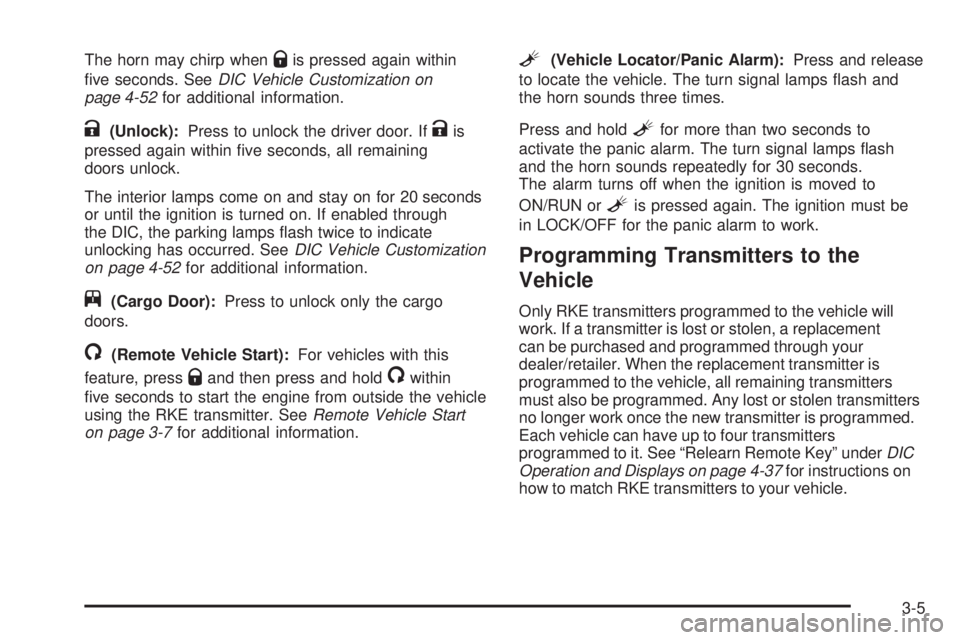
The horn may chirp whenQis pressed again within
five seconds. SeeDIC Vehicle Customization on
page 4-52for additional information.
K(Unlock):Press to unlock the driver door. IfKis
pressed again within five seconds, all remaining
doors unlock.
The interior lamps come on and stay on for 20 seconds
or until the ignition is turned on. If enabled through
the DIC, the parking lamps flash twice to indicate
unlocking has occurred. SeeDIC Vehicle Customization
on page 4-52for additional information.
j(Cargo Door):Press to unlock only the cargo
doors.
/(Remote Vehicle Start):For vehicles with this
feature, press
Qand then press and hold/within
five seconds to start the engine from outside the vehicle
using the RKE transmitter. SeeRemote Vehicle Start
on page 3-7for additional information.
L(Vehicle Locator/Panic Alarm):Press and release
to locate the vehicle. The turn signal lamps flash and
the horn sounds three times.
Press and hold
Lfor more than two seconds to
activate the panic alarm. The turn signal lamps flash
and the horn sounds repeatedly for 30 seconds.
The alarm turns off when the ignition is moved to
ON/RUN or
Lis pressed again. The ignition must be
in LOCK/OFF for the panic alarm to work.
Programming Transmitters to the
Vehicle
Only RKE transmitters programmed to the vehicle will
work. If a transmitter is lost or stolen, a replacement
can be purchased and programmed through your
dealer/retailer. When the replacement transmitter is
programmed to the vehicle, all remaining transmitters
must also be programmed. Any lost or stolen transmitters
no longer work once the new transmitter is programmed.
Each vehicle can have up to four transmitters
programmed to it. See “Relearn Remote Key” underDIC
Operation and Displays on page 4-37for instructions on
how to match RKE transmitters to your vehicle.
3-5